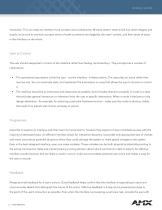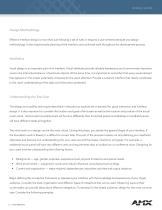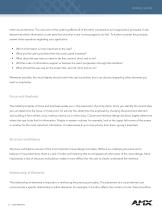
Catalog excerpts

Design Guide USER INTERFACE
Open the catalog to page 1
DESIGN GUIDE
Open the catalog to page 2
DESIGN GUIDE
Open the catalog to page 3
DESIGN GUIDE Overview AMX touch panels bridge a relationship between humans and technology, one that unfolds intuitively through the natural input of touch. This relationship is given space and form through the attention to design. Usability of an interface design is essential to the success of your touch panels. Investment in the design of your interfaces directly affects your customer’s ability to understand and use the touch panels. The wide use of features such as icons, gestural touch and nested navigation calls for an increased consistency between computers, mobile phones, kiosks and...
Open the catalog to page 4
DESIGN GUIDE task. As part of your design, it is recommended to consider adding help tools that describe tasks in further detail; however the primary system tasks should be clear and understandable without prior review of any help tools. You can help users be productive by promoting your interface’s key features and functions at the highest level of navigation on the initial start-up page. At the same time, avoid overwhelming users with all the features in your interface. Instead, consider exposing features gradually through layered navigation and contextual tips. Remember that your users’...
Open the catalog to page 5
DESIGN GUIDE interaction. This can make an interface more complex and cumbersome. Minimal doesn’t mean small, but rather elegant and simple, so be sure to maintain a proper sense of scale to preserve text legibility, the users’ context, and their sense of place in the interface on the whole. User in Control The user should always feel in control of the interface rather than feeling controlled by it. This principle has a number of implications: • The operational assumption is that the user - not the interface - initiates actions. The user plays an active rather than reactive role. You can...
Open the catalog to page 6
DESIGN GUIDE information about the state of the process and how to cancel the process if that is an option. Nothing is more disconcerting to users than a “dead” screen that is unresponsive to input. A typical user will tolerate only a few seconds of an unresponsive interface. It is equally important that the type of feedback you use be appropriate to the task. You can communicate simple information through button changes or a status bar message; for more complex feedback, you may need to display a progress control or message box. Focused Experiences Narrow the number of choices to the...
Open the catalog to page 7
DESIGN GUIDE Consistency Visuals must be consistent to help the users find their way through an interface. Consistency allows users to transfer existing knowledge to new tasks, learn new things more quickly and focus more attention on tasks. This is because they do not have to spend time trying to remember the differences in interaction. By providing a sense of stability, consistency makes the interface familiar and predictable. Consistency is important through all aspects of the interface, including names of tasks, visual presentation of information, operational behavior, and placement of...
Open the catalog to page 8
DESIGN GUIDE Design Methodology Effective interface design is more than just following a set of rules. It requires a user-centered attitude and design methodology. It also requires early planning of the interface and continued work throughout the development process. Aesthetics Visual design is an important part of an interface. Visual attributes provide valuable impressions and communicate important cues to the interactive behavior of particular objects. At the same time, it is important to remember that every visual element that appears on the screen potentially competes for the user’s...
Open the catalog to page 9
DESIGN GUIDE • Beginning users often have difficulty using a touch screen. For example, multi-touch gestures are skills that may take time for new users to remember. • Navigation on a touch panel can be difficult because it requires remembering the hierarchy and path they have traveled, which differs from a website with a crumb trail. • Sliding a finger is different from a tap selection, so many beginning users have difficulty distinguishing these two actions, or they overdo it. • Beginning users often have difficulty with window management. They do not always realize that overlapping...
Open the catalog to page 10
DESIGN GUIDE Interaction diagrams visualize the sequence of activities within an interface. The flow of actions needed to perform specific tasks is documented to ensure all needed functions are made available within the interface. Interaction diagrams are specifically helpful for complex tasks which require multiple actions to complete. Creating them is a key to catching interface errors early in the design process. Usability Assessment in the Design Process As described previously, usability testing is a key part of the design process. Usability assessment should begin early in the...
Open the catalog to page 11
DESIGN GUIDE other visual elements. The outcome of this ordering affects all of the other composition and organization principles. It also determines which information a user sees first and what a user is encouraged to do first. To further consider this principle, answer these questions regarding your application: • Which information is most important to the user? • What are the user’s priorities when the touch panel is started? • What does the user want or need to do first, second, third, and so on? • Will the order of information support or hamper the user’s progression through the...
Open the catalog to page 12
DESIGN GUIDE a spatial relationship between the button and the list. This helps the user make the connection clearly and quickly just by looking at the placement. Readability and Flow This principle calls for ideas to be communicated directly and simply with minimal visual interference. Readability and flow can determine the usability of a dialog box or other interface component. When you design the layout of a window, consider the following questions: • Could the idea or concept be presented more simply? • Can the user easily step through the interface? • Do all the elements have a reason...
Open the catalog to page 13All AMX catalogs and technical brochures
-
ENOVA DGX FAMILY
4 Pages
-
AMX Enova DVX
2 Pages
-
HydraPort
2 Pages
-
AMX Modero X Family
2 Pages
-
AMX Modero S Family
2 Pages
-
MVP-5200i Actual Size Piece
2 Pages
-
RMS® Overview
4 Pages
-
RPM
2 Pages
-
Enzo
4 Pages
-
AMX 2014 Pocket Guide
60 Pages
-
MVP-5150 Actual Size Piece
2 Pages
-
AMX Product Overview
15 Pages
-
HydraPort®
2 Pages
-
Modero X-Series Touch Panels
2 Pages
-
Modero S-Series Touch Panels
2 Pages
-
Enova® DVX Family
2 Pages
-
Enova® DGX Family
3 Pages
-
Central Controllers
32 Pages
-
ControlPads
30 Pages
-
2013 Pocket guide
112 Pages
-
Remotes
10 Pages
-
Touch Panels
96 Pages
Archived catalogs
-
Visual Architect
7 Pages
-
Video in the Home
6 Pages
-
Touch Panels
24 Pages
-
MVP-5200i
2 Pages
-
Meeting Manager
6 Pages
-
Matrix Mi Series
6 Pages
-
Matrix Delta Series
6 Pages
-
Lutron
6 Pages
-
KeyPads Brochure
12 Pages
-
Intelligent Manager
6 Pages
-
Inspired Signage
2 Pages
-
Home Manager
2 Pages
-
Exhibit Manager
2 Pages
-
Endeleo Distributed Media
6 Pages
-
Classroom Manager
6 Pages
-
AutoPatch Product catalog
12 Pages
-
AutoPatch Matrix Switchers
6 Pages
-
Worship Solutions
3 Pages
-
2005 Product Catalogue
140 Pages
-
2007 Fall Pocket Guide
29 Pages




























































